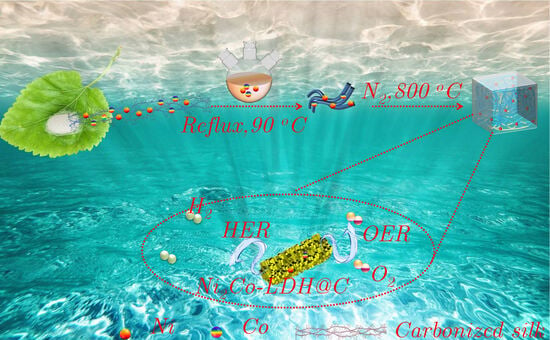Highly Effective Electrochemical Water Splitting with Enhanced Electron Transfer between Ni2Co Layered Double Hydroxide Nanosheets Dispersed on Carbon Substrate
Abstract
:1. Introduction
2. Materials and Methods
2.1. Degumming of Silk Worm Cocoons
2.2. Synthesis of NixCoy-LDH@C
2.3. Structure Characterizations
2.4. Electrocatalytic Measurements
3. Results
3.1. Characterization of Electrocatalysts
3.2. Electrocatalytic Performance for the HER
3.3. Electrocatalytic Performance for the OER
3.4. Overall Water Splitting Performance
3.5. Theoretical Calculation Analysis
4. Conclusions
Supplementary Materials
Author Contributions
Funding
Data Availability Statement
Acknowledgments
Conflicts of Interest
References
- Sun, T.; Tang, Z.Y.; Zang, W.J.; Li, Z.J.; Li, J.; Li, Z.H.; Cao, L.; Rodriguez, J.S.D.; Mariano, C.O.M.; Xu, H.; et al. Ferromagnetic single-atom spin catalyst for boosting water splitting. Nat. Nanotechnol. 2023, 18, 763–771. [Google Scholar] [CrossRef] [PubMed]
- Zang, Y.; Lu, D.Q.; Wang, K.; Li, B.; Peng, P.; Lan, Y.Q.; Zang, S.Q. A pyrolysis-free Ni/Fe bimetallic electrocatalyst for overall water splitting. Nat. Commun. 2023, 14, 1792. [Google Scholar] [CrossRef] [PubMed]
- Zhu, J.; Du, Q.X.; Khan, M.A.; Zhao, H.B.; Fang, J.H.; Ye, D.X.; Zhang, J.J. 2D porous Co-Mo nitride heterostructures nanosheets for highly effective electrochemical water splitting. Appl. Surf. Sci. 2023, 623, 156989. [Google Scholar] [CrossRef]
- Kharabe, G.P.; Illathvalappil, R.; Barik, S.; Kanheerampockil, F.; Walko, P.S.; Bhat, S.K.; Devi, R.N.; Kurungot, S. A cobalt–manganese modified theophrastite phase of nickel hydroxide nanoflower arrays on nickel foam as a self-standing bifunctional electrode for overall water electrolysis. Sustain. Energy Fuels 2023, 7, 2428–2440. [Google Scholar] [CrossRef]
- Liu, Z.Y.; Li, Y.; Peng, S.S.; Huang, J.; Su, B.L.; Gao, K.; Zhou, S.; Gao, Z.J.; Chen, T. A comprehensive melamine sponge decorated with 3D flowerlike Ag/NiCo-layered double hydroxide for wastewater remediation. J. Environ. Chem. Eng. 2022, 10, 108447. [Google Scholar] [CrossRef]
- Wijaya, R.A.; Suseno, A.; Lusiana, R.A.; Septina, W.; Harada, T. Synthesis of CuInS2 thin film photocathode with variation of sulfurization sources and Pt-In2S3 modification for photoelectrochemical water splitting. J. Electroanal. Chem. 2023, 945, 117683. [Google Scholar]
- Hu, Y.H.; Shen, T.Y.; Song, Z.H.; Wu, Z.H.; Bai, S.; Liu, G.H.; Sun, X.L.; Wang, Y.Y.; Hu, S.Y.; Zheng, L.R.; et al. Atomic Modulation of Single Dispersed Ir Species on Self-Supported NiFe Layered Double Hydroxides for Efficient Electrocatalytic Overall Water Splitting. ACS Catal. 2023, 13, 11195–11203. [Google Scholar] [CrossRef]
- Lee, D.E.; Moru, S.; Reddy, K.P.; Jo, W.K.; Tonda, S. Bimetallic Cu–Ni core–shell nanoparticles anchored N-doped reduced graphene oxide as a high-performance bifunctional electrocatalyst for alkaline water splitting. Appl. Surf. Sci. 2023, 622, 156928. [Google Scholar] [CrossRef]
- Liu, Z.; Liu, Y.X.; He, H.W.; Shao, H.B.; Zhang, Y.; Li, J.; Cai, W.W. Valence regulation of Ru/Mo2C heterojunction for efficient acidic overall water splitting. Electrochim. Acta 2023, 443, 141920. [Google Scholar] [CrossRef]
- Nguyen, T.H.T.; Zarkua, Z.; Chinnappa, C.V.; Hu, W.J.; Sree, S.P.; Grandjean, D.; Pant, D.; Janssens, E. Co3−xFexO4 inverse opals with tunable catalytic activity for high-performance overall water splitting. Nanoscale 2023, 15, 10306–10318. [Google Scholar] [CrossRef]
- Luo, J.B.; Zhou, Y.; Wang, X.Z.; Gu, Y.F.; Liu, W.L.; Wang, S.T.; Zhang, J. CoMoO4-CoP/NC heterostructure anchored on hollow polyhedral N-doped carbon skeleton for efficient water splitting. J. Colloid Interface Sci. 2023, 648, 90–101. [Google Scholar] [CrossRef]
- Pan, Y.D.; Gao, J.K.; Lv, E.J.; Li, T.T.; Xu, H.; Sun, L.; Nairan, A.; Zhang, Q.C. Integration of Alloy Segregation and Surface Co–O Hybridization in Carbon-Encapsulated CoNiPt Alloy Catalyst for Superior Alkaline Hydrogen Evolution. Adv. Funct. Mater. 2023, 33, 2303833. [Google Scholar] [CrossRef]
- Jing, F.L.; Pi, Y.Y.; Zhao, C.X.; Zhou, H.; Luo, S.Z.; Fang, W.H. Constructing highly stable dendritic silica-wrapped NiCo/carbon nanotubes architecture for hydrogen production. Mater. Today Sustain. 2022, 19, 100183. [Google Scholar] [CrossRef]
- Liu, B.H.; Li, S.Y.; Wang, T.Q.; Yang, Y.; Wang, L.X.; Zhang, X.; Liu, Z.C.; Niu, L.W. Construction of CoFe bimetallic phosphide microflowers electrocatalyst for highly efficient overall water splitting. Catal. Commun. 2023, 175, 106607. [Google Scholar] [CrossRef]
- Li, N.; Qu, S.J.; Qin, F.F.; Li, H.Y.; Shen, W.Z. Construction of P,N-codoped carbon shell coated CoP nanoneedle array with enhanced OER performance for overall water splitting. Int. J. Hydrogen Energy 2023, 48, 27215–27230. [Google Scholar] [CrossRef]
- Li, N.; Qu, S.J.; Ma, J.J.; Shen, W.Z. Core-shell-structured CoS2@N-doped carbon nanoneedle array as an efficient bifunctional electrocatalyst for overall water splitting. Int. J. Hydrogen Energy 2023, 48, 180–195. [Google Scholar] [CrossRef]
- Yang, M.; Cui, Z.; Wang, Q.H.; Yin, J.F.; Yang, L.; Wang, O.; Deng, G.W. Improvement of specific capacitance and rate performance of NiWO4 synthesized through modified chemical precipitation. J. Mater. Sci. Mater. Electron. 2021, 32, 12232–12240. [Google Scholar] [CrossRef]
- He, X.D.; Han, X.; Zhou, X.Y.; Chen, J.D.; Wang, J.; Chen, Y.; Yu, L.H.; Zhang, N.; Li, J.; Wang, S.; et al. Electronic modulation with Pt-incorporated NiFe layered double hydroxide for ultrastable overall water splitting at 1000 mA cm−2. Appl. Catal. B Environ. 2023, 331, 122683. [Google Scholar] [CrossRef]
- Chen, K.; Cao, Y.H.; Yadav, S.; Kim, G.C.; Han, Z.; Wang, W.M.; Zhang, W.J.; Dao, V.; Lee, I. Electronic structure reconfiguration of nickel–cobalt layered double hydroxide nanoflakes via engineered heteroatom and oxygen-vacancies defect for efficient electrochemical water splitting. Chem. Eng. J. 2023, 463, 142396. [Google Scholar] [CrossRef]
- Peng, M.W.; Zhao, B.; Shi, D.L.; Wang, Y.W.; Li, D.; Liang, W.K.; Yang, H.; Liang, Z.Q.; Sun, Y.H.; Jiang, L. Enabling high loading of well-dispersed Ni2CoP2 catalysts on a 3D-printed electrode for efficient electrocatalysis. J. Mater. Chem. A 2023, 11, 15394. [Google Scholar] [CrossRef]
- Li, G.L.; Miao, Y.Y.; Qiao, X.Y.; Wang, T.Y.; Deng, F. Engineering edge sites based on NiS2/MoS2/CNTs heterojunction catalyst for overall water splitting. Appl. Surf. Sci. 2023, 615, 156309. [Google Scholar] [CrossRef]
- Fei, L.S.; Sun, H.N.; Xu, X.M.; Li, Y.; Ran, R.; Zhou, W.; Shao, Z.P. Understanding the bifunctional catalytic ability of electrocatalysts for oxygen evolution reaction and urea oxidation Reaction: Recent advances and perspectives. Chem. Eng. J. 2023, 471, 144660. [Google Scholar] [CrossRef]
- Yang, H.S.; Fu, Q.; Hou, Y.; Yu, J.X.; Tong, Y.J.; Li, N.; Zhong, H.J.; Zhu, F.; Wang, J.H.; Hao, Z.P.; et al. Ultrahigh surface area of single-atom iron nanosheets assists in the efficient utilization of reactive oxygen species in the peroxymonosulfate activation process for pollutant removal. Environ. Sci. Nano 2023, 10, 1152. [Google Scholar] [CrossRef]
- Huang, Q.P.; Jiang, M.J.; Li, Y.Y.; Liang, C.; Tang, Y.M.; Xie, F.Y.; Yang, M.; Deng, G.W. Construction of MnxCoyO4/Ti electrocatalysts for efficient bifunctional water splitting. Dalton Trans. 2022, 51, 9085. [Google Scholar] [CrossRef]
- Sun, A.; Qiu, Y.L.; Wang, Z.X.; Cui, L.; Xu, H.Z.; Zheng, X.Z.; Xu, J.T.; Liu, J.Q. Interface engineering on super-hydrophilic amorphous/crystalline NiFe-based hydroxide/selenide heterostructure nanoflowers for accelerated industrial overall water splitting at high current density. J. Colloid Interface Sci. 2023, 650, 573–581. [Google Scholar] [CrossRef]
- Qiu, S.P.; Zhang, B.J.; Wang, X.; Huang, J.Z.; Zhao, G.; Ding, M.; Xu, X.J. Interface strong-coupled 3D Mo-NiS@Ni-Fe LDH flower-cluster as exceptionally efficient electrocatalyst for water splitting in wide pH range. J. Colloid Interface Sci. 2023, 641, 277–288. [Google Scholar] [CrossRef]
- Nayem, S.M.A.; Islam, S.; Aziz, M.A.; Ahammad, A.J.S. Mechanistic insight into hydrothermally prepared molybdenum-based electrocatalyst for overall water splitting. Electrochim. Acta 2023, 445, 142050. [Google Scholar] [CrossRef]
- Ma, G.Y.; Ye, J.T.; Qin, M.Y.; Sun, T.Y.; Tan, W.X.; Fan, Z.H.; Huang, L.F.; Xin, X. Mn-doped NiCoP nanopin arrays as high-performance bifunctional electrocatalysts for sustainable hydrogen production via overall water splitting. Nano Energy 2023, 115, 108679. [Google Scholar] [CrossRef]
- Gu, R.Z.; Zhou, T.; Wang, Z.H.; Chen, Z.; Tao, J.W.; Fan, Z.W.; Guo, L.Y.; Liu, Y.S. Mo/P doped NiFeSe as bifunctional electrocatalysts for overall water splitting. Int. J. Hydrogen Energy 2023, 48, 27642–27651. [Google Scholar] [CrossRef]
- Gao, Y.H.; He, W.J.; Cao, D.; Wang, F.Q.; Li, Y.; Hao, Q.Y.; Liu, C.C.; Liu, H. Mo-Doped Ni3S2 Nanosheet Arrays for Overall Water Splitting. ACS Appl. Nano Mater. 2023, 6, 6066–6075. [Google Scholar] [CrossRef]
- You, T.; Deng, K.; Liu, P.; Lv, X.B.; Tian, W.; Li, H.J.; Ji, J.Y. Synergism of NiFe layered double hydroxides/phosphides and Co-NC nanorods array for efficient electrocatalytic water splitting. Chem. Eng. J. 2023, 470, 144348. [Google Scholar] [CrossRef]
- Ning, S.L.; Wu, Q.K.; Zhu, Y.G.; Liu, S.L.; Zhou, W.; Mi, L.; Zhou, K.; Zhao, D.K.; Zhang, X.Y.; Wang, N. N-doped carbon nanowire array confined cobalt phosphides as efficient bifunctional electrocatalysts for water splitting. Inorg. Chem. Front. 2023, 10, 2145–2153. [Google Scholar] [CrossRef]
- Xie, Y.H.; Feng, Y.M.; Jin, S.Y.; Li, C.; Li, C.S.; Sun, Y.; Luo, F.; Yang, Z.H. Nickel-doped iridium echinus-like nanosheets for stable acidic water splitting. Chem. Commun. 2023, 59, 8404–8407. [Google Scholar] [CrossRef] [PubMed]
- Xia, W.; Luan, X.X.; Zhang, W.; Wu, D.F. Sulfuration of hierarchical Mn-doped NiCo LDH heterostructures as efficient electrocatalyst for overall water splitting. Int. J. Hydrogen Energy 2023, 48, 27631–27641. [Google Scholar] [CrossRef]
- Ge, J.M.; Diao, S.T.; Jin, J.X.; Wang, Y.P.; Zhao, X.H.; Zhang, F.Z.; Lei, X.D. NiFeCu phosphides with surface reconstruction via the topotactic transformation of layered double hydroxides for overall water splitting. Inorg. Chem. Front. 2023, 10, 3515–3524. [Google Scholar] [CrossRef]
- Wang, Y.F.; Ye, Q.; Lin, L.; Zhao, Y.X.; Cheng, Y.L. NiFeRu/C and Ru, Fe-Ni5P4/C as complementary electrocatalyst for highly efficient overall water splitting. J. Colloid Interface Sci. 2023, 651, 1008–1019. [Google Scholar] [CrossRef]
- Karmakar, A.; Krishnan, A.V.; Jayan, R.; Madhu, R.; Islam, M.M.; Kundu, S. Structural modulation of low-valent iron in LDH-derived Ni3Se4 nanosheets: A breakthrough electrocatalyst for the overall water splitting reaction. J. Mater. Chem. A 2023, 11, 10684–10698. [Google Scholar] [CrossRef]
- Xu, X.M.; Pan, Y.L.; Ge, L.; Chen, Y.B.; Mao, X.; Guan, D.Q.; Li, M.R.; Zhong, Y.J.; Hu, Z.W.; Peterson, V.K.; et al. High-Performance Perovskite Composite Electrocatalysts Enabled by Controllable Interface Engineering. Small 2021, 17, 2101573. [Google Scholar] [CrossRef]
- Wang, H.M.; Feng, T.; Wang, L.C.; Hao, W.J. Quantum dot-doped CeOx–NiB with modulated electron density as a highly efficient bifunctional electrocatalyst for water splitting. Nanoscale 2023, 15, 6321–6332. [Google Scholar] [CrossRef]
- Xu, X.M.; Yang, K.F.; She, J.Z.; Zhai, Y.S.; Zhou, M.H.; Deng, R.H.; Li, Z.M.; Cai, H. Self-supporting and bifunctional Cu-based electrocatalysts with porous structures as superior working electrodes for alkaline water splitting. CrystEngComm 2023, 25, 1276–1285. [Google Scholar] [CrossRef]

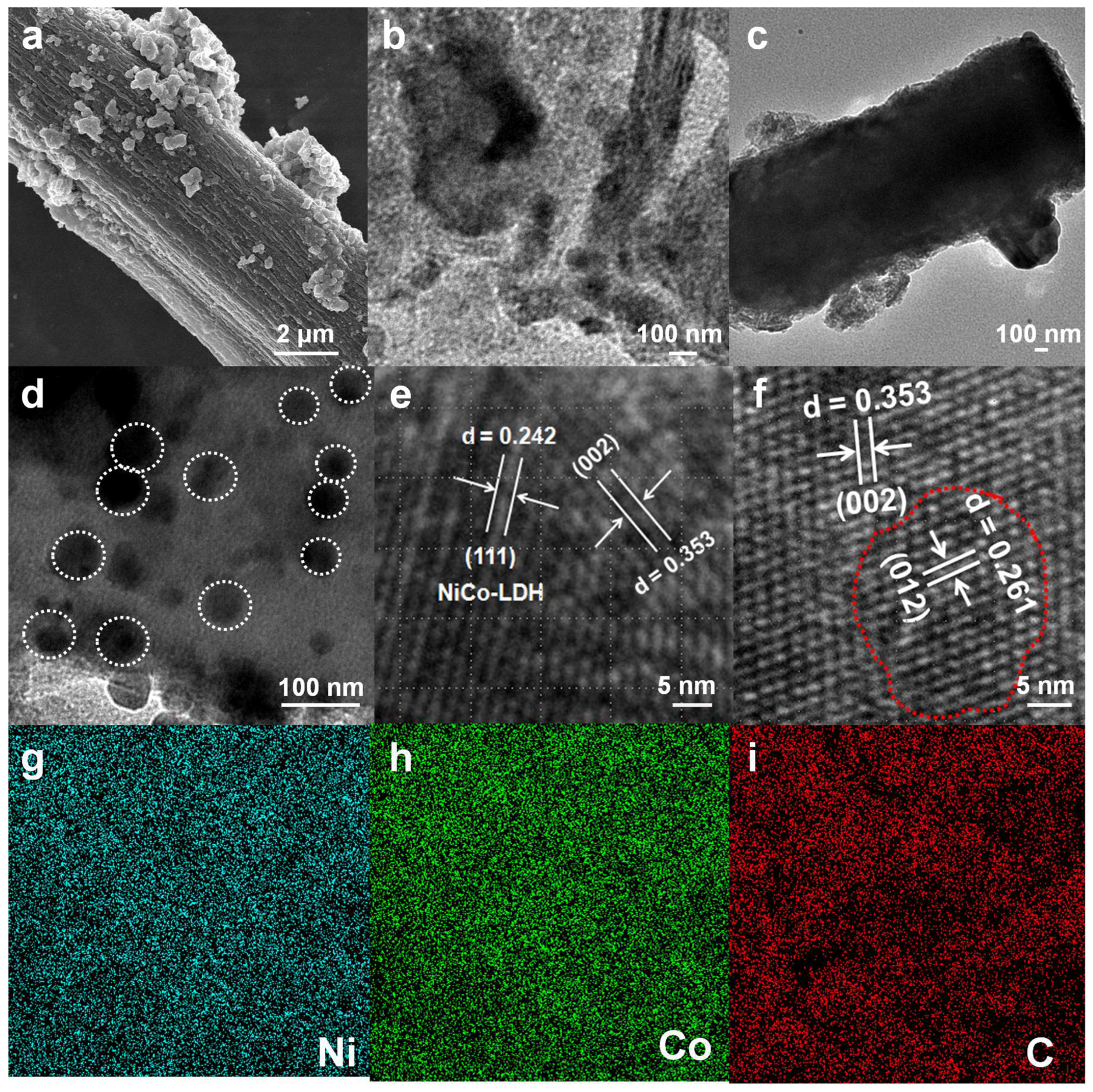
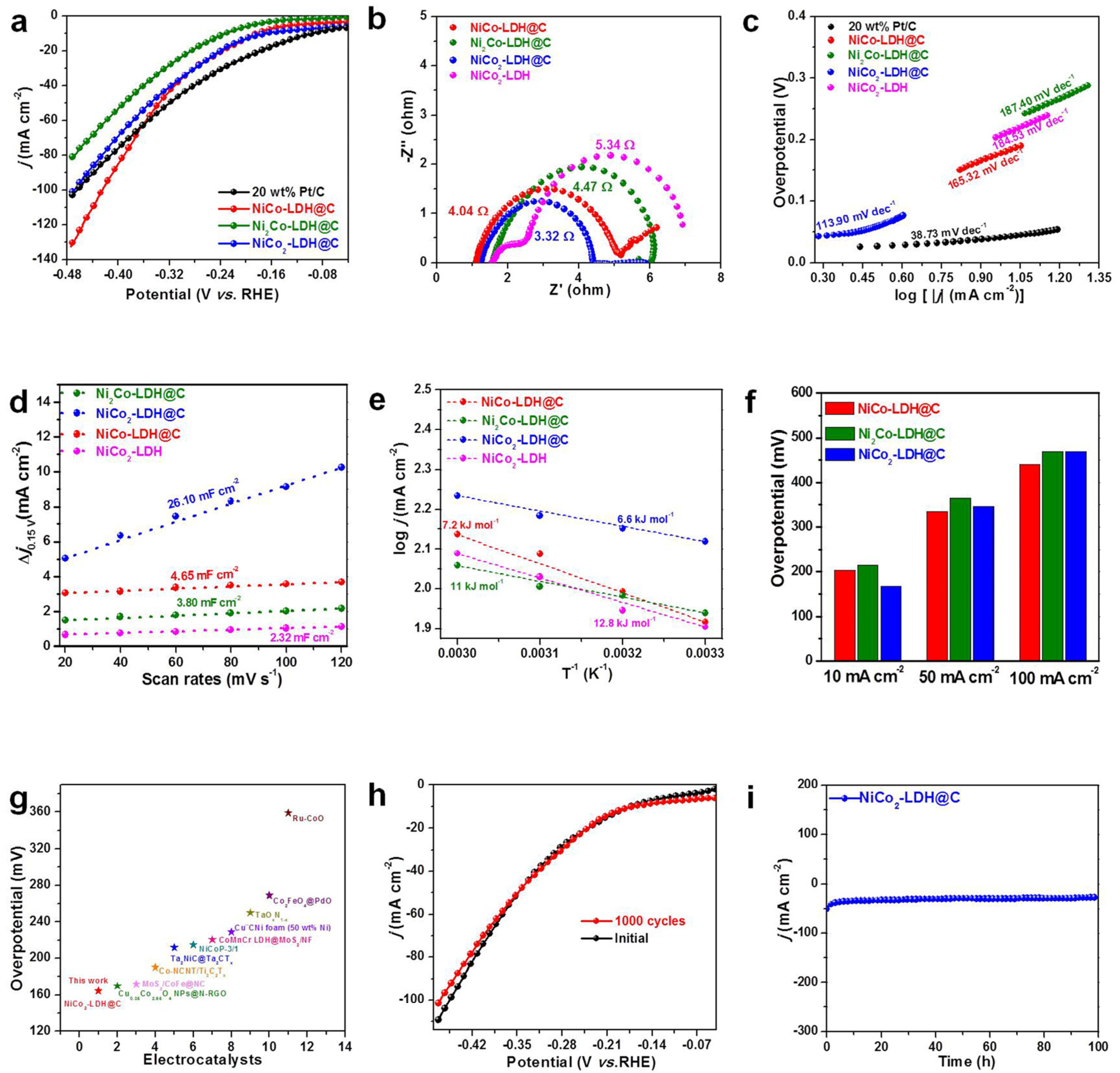
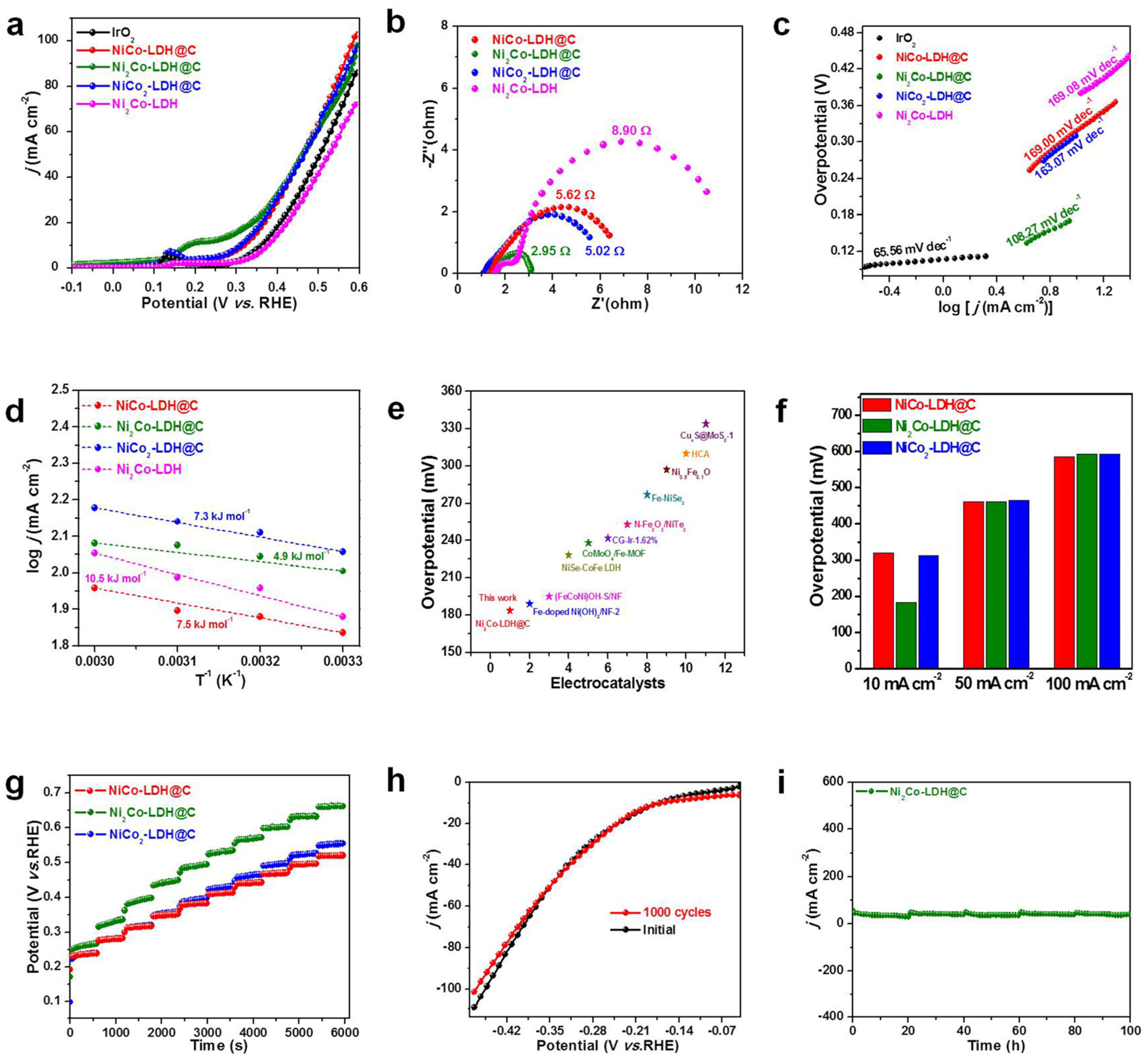
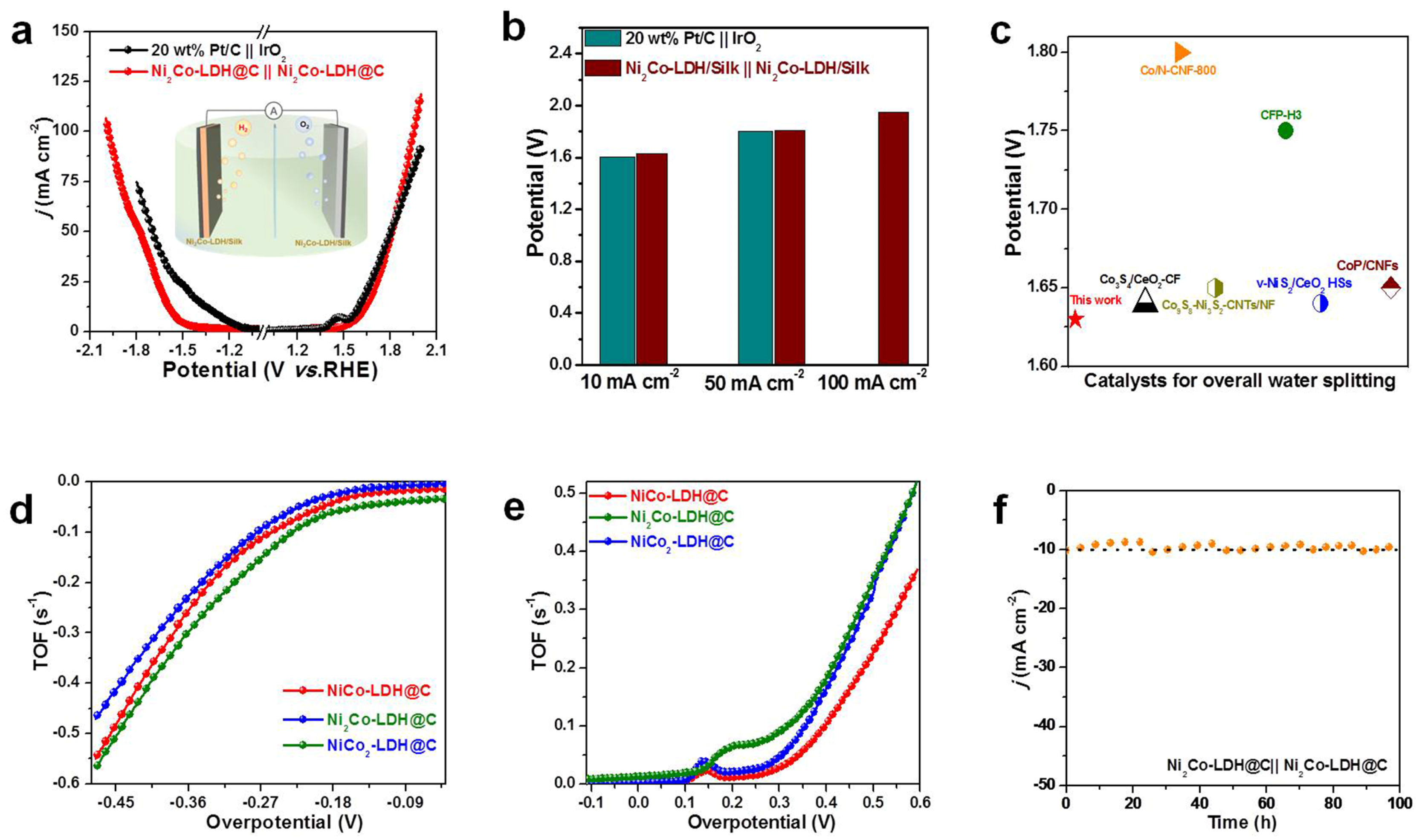

Disclaimer/Publisher’s Note: The statements, opinions and data contained in all publications are solely those of the individual author(s) and contributor(s) and not of MDPI and/or the editor(s). MDPI and/or the editor(s) disclaim responsibility for any injury to people or property resulting from any ideas, methods, instructions or products referred to in the content. |
© 2023 by the authors. Licensee MDPI, Basel, Switzerland. This article is an open access article distributed under the terms and conditions of the Creative Commons Attribution (CC BY) license (https://creativecommons.org/licenses/by/4.0/).
Share and Cite
Wan, Z.; Tang, P.; Dai, L.; Yang, Y.; Li, L.; Liu, J.; Yang, M.; Deng, G. Highly Effective Electrochemical Water Splitting with Enhanced Electron Transfer between Ni2Co Layered Double Hydroxide Nanosheets Dispersed on Carbon Substrate. C 2023, 9, 94. https://doi.org/10.3390/c9040094
Wan Z, Tang P, Dai L, Yang Y, Li L, Liu J, Yang M, Deng G. Highly Effective Electrochemical Water Splitting with Enhanced Electron Transfer between Ni2Co Layered Double Hydroxide Nanosheets Dispersed on Carbon Substrate. C. 2023; 9(4):94. https://doi.org/10.3390/c9040094
Chicago/Turabian StyleWan, Ziyi, Ping Tang, Luwei Dai, Yao Yang, Lu Li, Jun Liu, Min Yang, and Guowei Deng. 2023. "Highly Effective Electrochemical Water Splitting with Enhanced Electron Transfer between Ni2Co Layered Double Hydroxide Nanosheets Dispersed on Carbon Substrate" C 9, no. 4: 94. https://doi.org/10.3390/c9040094
APA StyleWan, Z., Tang, P., Dai, L., Yang, Y., Li, L., Liu, J., Yang, M., & Deng, G. (2023). Highly Effective Electrochemical Water Splitting with Enhanced Electron Transfer between Ni2Co Layered Double Hydroxide Nanosheets Dispersed on Carbon Substrate. C, 9(4), 94. https://doi.org/10.3390/c9040094




